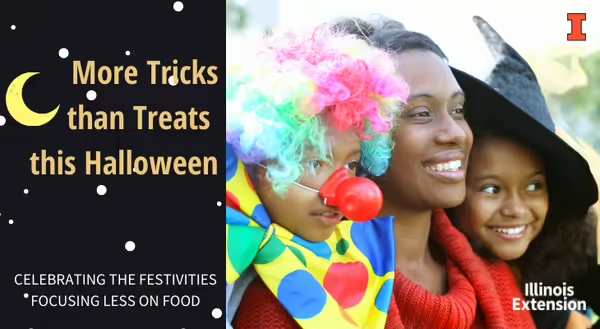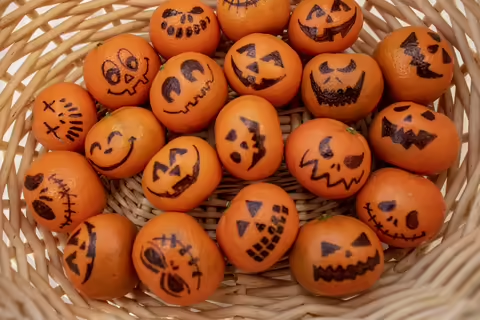
Often a day of candy, treats, and sugar, a "healthy" Halloween might well be an oxymoron. By focusing more on getting dressed up and the fun of playing games and tricks, kids and adults can focus less on food and more on the festivities.
Giving Out (Tricks or) Treats
There is nothing wrong with giving out classic Halloween candy. But if it appeals to you to offer non-food treats (like supporting the Teal Pumpkin Project) or add in nutrition at Halloween, consider these ideas:
Non-food treats
- glow-in-the-dark sticks
- themed pencils and stickers
- colored toothbrushes
- themed costume items, like fake teeth and eyeballs
- pennies or other coins
- small toys, like whistles and jump ropes
Treats adding in nutrition
- pre-packaged reduced-sugar granola bars
- individually-packaged popped popcorn
- pumpkin spice-flavored instant oatmeal packets
- snack-sized packages of dried apple chips
- snack-sized packages of cheese crackers (made with whole grains)
- whole mandarin oranges (maybe decorated like a pumpkin!)
Getting in the Kitchen Together
Maybe Halloween night isn't the night to worry about cooking with your kids. But consider celebrating the season another night with themed meals or recipes. The Peanut Butter Pumpkin Dip below is definitely a favorite among Illinois Extension staff. And it's simple enough to make with kids. They can practice measuring, mixing, and using a can opener in their costumes!
Pumpkin Peanut Butter Dip | Watch video
Serves 12 (2 Tbsp per serving)
3/4 cup peanut butter
1-4 Tbsp brown sugar (to taste)
1 tsp vanilla extract
3/4 cup canned pumpkin
- Wash hands with soap and water.
- In a medium bowl, mix peanut butter, brown sugar, and vanilla until smooth.
- Add pumpkin and stir until well blended. Cover and refrigerate until ready to eat.
- Serve with graham crackers, apple slices, celery sticks, or other dippers.
- Refrigerate or freeze the remaining pumpkin puree and try some new recipes.
Nutrition Facts per serving (calculated with 2 Tbsp brown sugar): 110 calories, 8g fat, 70mg sodium, 6g carbohydrates, 1g fiber, 4g protein
Recipe from Illinois Nutrition Education Programs.
Communicating about Candy
Of course, kids will get excited about their haul of treats! And they might want to eat it all right after finishing Trick or Treat. Try some of these talking points.
- Skip the "good vs. bad" food language. Candy is certainly low in nutrients but serves other roles for us like enjoyment, taste, and satisfaction. Using phrases like "play food" or "fun food" helps communicate that treats can have other roles besides nutrition.
- Invite your kids to practice mindful eating. An easy mindful eating practice with Halloween treats is to do a 5-sense observation. Ask your kids to describe the look, smell, taste, texture, and sounds a candy or treat has. Is it crunchy? Sticky? Sweet smelling?
- Guide eating with curiosity. Did your kiddo eat too much or too fast and feels sick? There's no need to scold them that they shouldn't have eaten so much or to slow down. Instead, ask them why they think their stomach is upset, or tell them a story of when you ate too much and felt uncomfortable too. This helps kids learn that they can tune into how their bodies feel when eating food.
- Join in! Eat sweet treats in front of your kids, modeling that the adults in their lives can enjoy candy, like they enjoy higher-nutrient foods too. We adults can show that candy and sweets are not something to avoid, restrict, or police. This acceptance of all foods can is important in developing a good relationship with foods.
Post originally published in 2014; content updated in 2021.
Healthy Eats and Repeat
How much difference is there between canned and frozen foods? How should you cook venison? When is the best time to buy avocados? Get answers to these questions as well as other tips, tutorials and recipes for common kitchen foods and items with University of Illinois Extension Nutrition & Wellness Educator Caitlin Mellendorf’s blog Healthy Eats and Repeat. Build your best life. Trust Extension to help.
Caitlin Mellendorf is an Illinois Extension Nutrition and Wellness Educator serving DeWitt, Macon and Piatt Counties in Central Illinois. She is a Registered Dietitian and her work focuses on helping community members gain the knowledge, skills and tools to live healthier, more nutritious lifestyles. This includes providing programs and answering questions about heart health, diabetes, food safety, food preservation, grocery shopping and cooking. You can reach Caitlin by email at chuth2@illinois.edu or call 217.877.6042. Check out her nutrition blog Healthy Eats and Repeats for seasonal recipes and of an exploration of common kitchen foods.


